Flag of El Salvador
This article needs additional citations for verification. (June 2021) |
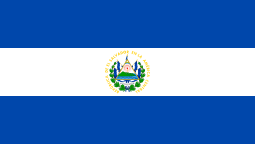 | |
| Name | Bandera Magna (Magna flag) (in Spanish) |
|---|---|
| Use | State and war flag, naval ensign |
| Proportion | 189:335,[1] approximately 9:16 |
| Adopted | May 27, 1912 |
| Design | A horizontal triband of cobalt blue (top and bottom) and white with the National Coat of Arms in the center and occupying the entire width of the white stripe with its top touching the upper blue strip and its base touching the lower blue stripe. |
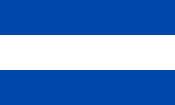 Variant flag of El Salvador | |
| Use | Civil flag |
| Proportion | 3:5 |
| Design | A horizontal triband of white within cobalt blue |
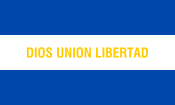 Variant flag of El Salvador | |
| Use | State and war flag, civil and state ensign |
| Proportion | 3:5 |
| Design | A horizontal triband of white within cobalt blue, the words "DIOS UNION LIBERTAD" in golden amber centered and occupying almost the entire length and width of the white stripe |
The flag of El Salvador features a horizontal triband of cobalt blue-white-cobalt blue, with the coat of arms centered and entirely contained within the central white stripe. This design of a triband of blue-white-blue is commonly used among Central American countries. Along with Afghanistan, Bolivia, Costa Rica, the Dominican Republic, Ecuador, Haiti, and Venezuela, it is one of only eight national flags which has a depiction of its flag within the flag itself.[2]
Features[]




The colors signify:
- Cobalt blue: represents the skies of the country and two massive oceans of Central America.
- White: represents peace, concordia and solidarity with the world
- Golden Amber: represents the entire bold phraseology in the flag, the coat of arms of El Salvador; the bold equilateral triangle, 5 indigenous spears, beaming solar rays, scroll, the bold motto (God Union Liberty) and the bold etymology (Republic of El Salvador in Central America)
- The flag has the words (REPÚBLICA DE EL SALVADOR EN LA AMÉRICA CENTRAL) in a bold and Heavy, Sans Serif Boris Black Bloxx typeface, in a golden amber color
- The national motto (DIOS UNIÓN LIBERTAD) in Trajan bold Roman square capitals. The letter are colored amber gold on the civil flag, and black in the coat of arms
- The date (15 DE SEPTIEMBRE DE 1821) in Trajan bold Roman square capitals
The blue hue is a vivid, lustrous and luscious rich solid cobalt blue. In the center of and occupying the entire width of the white stripe is the coat of arms with its top touching the upper blue strip and its base touching the lower blue stripe. The coat of arms contains the in bold golden amber words "REPÚBLICA DE EL SALVADOR EN LA AMÉRICA CENTRAL" (English: Republic of El Salvador in Central America). There are two variant flags, one without the coat of arms, and the other with the words "DIOS UNIÓN LIBERTAD" (English: God, Union, Liberty) in bold golden amber in place of the coat of arms. All three contain the same cobalt blue and white stripes, occasionally with a gold Fringe (trim). The main flag has an aspect ratio of 189:335 while the variants are both 3:5.[3]
From 1865 to 1912, a different flag was in use, with a field of alternating cobalt blue and white stripes and a red canton containing stars. The designs of both sides of the flag are different; at the reverse side, it shows the then national coat of arms at the position of stars at obverse. The stars symbolized the provinces of the Republic; once a new province was created, one star was add to the obverse of the flag. This "Star-Striped" banner was considered to be inspired by the flag of the United States.
The blue stripes symbolize the ocean and sky. The white means Peace. Blue is an important color in Salvadoran culture and identity. It started with Native American cultures of Mesoamerica in El Salvador, that produced (añil) indigo plant which they used extracts to produce blue dyes. When the Europeans invaded and colonized the area, they saw the wealth of indigo and turned El Salvador to one of the world's foremost providers of indigo dye in its time.
Many other countries in Central America use blue and white colors as a Pan-Central American symbol.
Synonymous to the country's wealth, the colonizers referred to the dye as "the blue gold", that dominated El Salvador's economy until it was completely replaced by coffee cultivation. Today El Salvador remains as one of the few countries in the world that still cultivates indigo to produce blue dyes. Over time El Salvador's flag has had several different shades of blue, from the lightest to darkest, including Royal blue, Sapphire, Klein Blue and Indigo. The present current modern flag displays a cobalt blue color.

President of El Salvador Nayib Bukele wearing the presidential sash with the national flag standing behind

The five rowed volcanos in the coat of arms were inspired by the Cordillera de Apaneca volcanic range when El Salvador's Sonsonate City was the second capital of the Federal Republic of Central America in 1834.]

The first coat of arms which declared the country's citizens as Salvadorans
El Salvador under Spain's reign[]
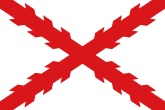
New Spain 1525-1821

Spanish Empire 1525-1821
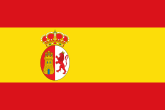
Intendancy of San Salvador 1785–1821
Historical coat of arms of El Salvador[]

The United Provinces of Central America (1823–1825)

Federal Republic of Central America (1825–1841)

National Representation of Central America (1851–1853)

Greater Republic of Central America (1895–1898)

El Salvador (1877–1912)

El Salvador (1912–present)
Historical flags of El Salvador[]

February 20, 1822 – February 10, 1823, 1841–1842, 1844 – May 9, 1865 (as part of United Provinces of Central America) (civil flag)

August 21, 1823 – 1824, 1842–1844 (as part of United Provinces of Central America)

1823-1824, (Military Flag of the United Provinces of Central America),(with national motto and national battalion initials)

1824–1841, 1921–1922 (as part of Federal Republic of Central America)

Flag of El Salvador May 9 – June 1865

June 1865 – 1869

1869–1873

1873–1877

November 2 – November 30, 1898 (as part of Greater Republic of Central America)

1877 – November 2 1898, and November 30 1898 – May 17, 1912

1877 – November 2 1898, and November 30 1898 – May 17, 1912
(Reverse side)
Flag of El Salvador (1912–present)
Historic Salvadoran flag displays[]
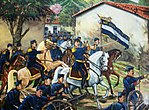
President Gerardo Barrios, El Salvador 1861, with an earlier version that inspired the modern flag
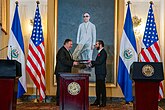
U.S and El Salvador flags stand behind Mike Pompeo and Nayib Bukele, in San Salvador, El Salvador, July 21, 2019.

President Barack Obama and First Lady Michelle Obama greet children waving U.S and El Salvador flags during the arrival ceremony at Comalapa International Airport in San Salvador, El Salvador

Flag of El Salvador displayed alongside former Salvadoran president Francisco Flores Pérez, 2001
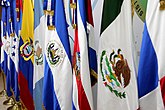
Flag of El Salvador (center) displayed at the Community of Latin American and Caribbean States
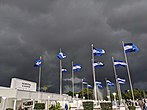
Salvadoran flag stand in front of Hospital El Salvador
El Salvador flag on top of the National Palace in San Salvador
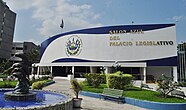
Flag of El Salvador displayed on the legislative Palace Salon Azul, San Salvador

The Coat of arms of El Salvador displayed at the site from which, on the morning of November 5, 1811, the first cry for the independence of Central America was launched

The Coat of Arms of El Salvador displayed in the Barcelona consulate

The Coat of arms of El Salvador displayed in The Torch of Friendship monument in Downtown Miami, Florida
Coat of arms of El Salvador displayed on the El Zapote Military Museum, San Salvador

The coat of arms of El Salvador displayed on Virgin Our Lady of Peace in Nazaret, Israel

The Coat of Arms of El Salvador displayed on Virgin Our Lady of Peace in the Cathedral Basilica of Queen of Peace, San Miguel

Flag of El Salvador displayed in the First UN poster, August 1942, Wartime poster for the Allies of World War II, created in 1942 by the US Office of War Information, showing the 26 members of the alliance, Declaration by United Nations

Flag of El Salvador displayed in Wartime poster for the United Nations, created in 1941 by the US Office of War Information. The United Nations fight for freedom. Poster depicts an etching of the Statue of Liberty on a black background on the left side of the poster. On the right there are pictures of flags of 30 countries. Poster has black background with white text at the top of the page and a white border all around.

Flag of El Salvador displayed in Wartime poster for the Allies of World War II, created in 1943 by the US Office of War Information. Poster created during the Second World War (1943), according to the Declaration of the United Nations of 1942. The Poster, created by United States Office of War Information and made by United States Government Printing Office. The poster features the flags of those countries or governments-in-exile that pledged to support the Allied effort the on-going war machine that the United Nations represented.

Flag of El Salvador displayed in "Flags of Maritime Nations" between 1941 and 1945

Flag of El Salvador displayed in "UNITED NATIONS FLAGS" between 1941 and 1945

Flag of El Salvador displayed in (Flags of the United Nations), 7 May 1953
References[]
- ^ "Flag of El Salvador". Encyclopedia Britannica. Retrieved 2018-10-13.
- ^ Minahan, James. (2010). The complete guide to national symbols and emblems. Santa Barbara, Calif.: Greenwood Press. ISBN 978-0-313-34496-1. OCLC 436221284.
- ^ *Art.7. "La bandera magna será de tres metros treinta y cinco centímetros de largo por un metro ochenta y nueve centímetros de ancho, en la cual irá dibujado el Escudo de Armas con todos sus blasones." (The greater flag is 3m 35cm long and 1m 89cm wide and includes the entire national coat of arms)
- Art.9. "La bandera de uso en edificios y oficinas públicos, será de un metro de largo por sesenta centímetros de ancho (..) En la franja del centro llevará la leyenda: DIOS UNION LIBERTAD" (The flag for use at public buildings is 1m long by 60cm wide (..) The central stripe shall bear the inscription 'Dios Union Libertad')
- Art.11. "La bandera de desfiles deberá medir un metro cuarenta y cinco centímetros de largo por noventa centímetros de ancho (..) La franja blanca de la bandera para desfiles, llevará en letras doradas la inscripción: DIOS UNION LIBERTAD" (The flag for use at parades will be 1.45m long by 90cm wide (..) The white stripe of the flag for parades shall bear in golden letters the inscription 'Dios Union Libertad')
- Flags introduced in 1912
- National flags
- National symbols of El Salvador













































